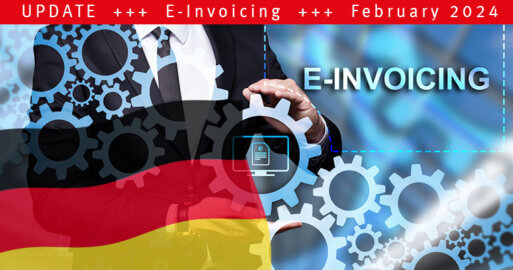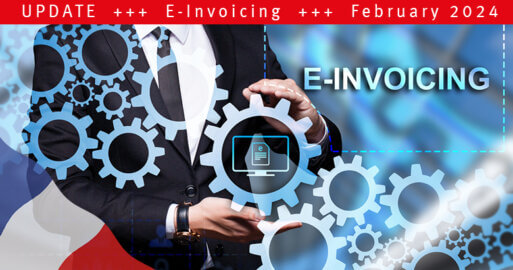XRechnung Version 3.0.1 Comes Into Force on February 1, 2024

On February 1, 2024, a new version of XRechnung will be coming into force. Version 3.0.1 marks a major release and introduces new mandatory fields. This means that details that had previously been optional will now need to be entered. This version lets you send electronic invoices to recipients who are connected to the central federal invoicing portals ZRE or OZG-RE.
As is the case with every new version, the previous version 2.3.1 becomes invalid from this point onwards. When sending e-invoices, you should use the latest X-Rechnung standard as public bodies are not obliged to accept an invoice in an obsolete version.
This blog will be taking a closer look at the new XRechnung version and the implications for your business.
Read our blog Electronic Invoicing to Become Mandatory in the German B2B Sector: What, Why and How? to learn more about E-invoicing in Germany. In particular the standardized XRechnung format, plays a central role in this revolution and electronic invoices.
Why have things changed in XRechnung version 3.0.1?
That this version is a major release is reflected in the fact that the first digit of the release number has been replaced by a three. To this end, version 3.0.1 may encompass new rules, which may lead to recipients having to reject previously approved invoices. Alternatively, as was the case with release 2.0, this could also mean that the standard has been extended.
The German IT standards coordination agency KoSIT has applied for the national business rules of XRechnung to be adopted as a National Ruleset in the Peppol BIS Billing 3.0 specification.
Like XRechnung, Peppol BIS Billing 3.0 is a core invoice usage specification (CIUS) for the European core invoice/EN-16931. In addition to the business rules resulting directly from EN-16931, a CIUS has extended rules. The national rulesets in Peppol BIS Billing 3.0 cover additional country-specific business rules that apply depending on the country of the invoice issuer.
The National Rulesets for Germany have not yet been published in the “Peppol BIS Billing 3.0 Rulesets”.
If using Peppol, it will no longer be necessary to send an XRechnung as the National Ruleset in the Peppol BIS Billing 3.0 standard also covers the XRechnung regulations for senders from Germany. This will make it easier for companies that issue electronic invoices in Germany and beyond to use the Peppol network as this change lets you enable a specification to be used both domestically and across borders.
Outside of the Peppol network, however – basically when sending an invoice by email – you also need to be able to use the national specification. Therefore, the CIUS XRechnung needs to be retained as a standard component of the XRechnung standard. In order to minimize the differences in the business rules between Peppol BIS Billing 3.0, the German National Ruleset and XRechnung, core rules from the Peppol standard have also been adopted in XRechnung 3.0.1.
The basic rules mainly relate to provisions that refer to standard definitions but are slightly different in their business rules form and validation artefacts.
What new or changed business rules are in version 3.0.1?
XRechnung version 3.0.1 has adopted the following business rules from Peppol BIS Billing 3.0
| ID | Description | Comments |
| PEPPOL-EN16931-R001 | The element Business process type (BT-23) must be transmitted. | Standard value: ”urn:fdc:peppol.eu:2017:poacc:billing:01:1.0“ as per Peppol specification. |
| PEPPOL-EN16931-R005 | If the element VAT accounting currency code (BT-6) is transmitted in an invoice, the transmitted code must differ from the transmitted code in the element Invoice currency code (BT-5). | The VAT accounting currency code is only transferred if the invoice currency is different from the tax currency. E.g., a seller from Sweden states the tax in his home currency, i.e. Swedish kronor, but the invoice is in EUR as it is issued to recipients in the eurozone. |
| PEPPOL-EN16931-R008 | A document may not contain any empty elements. | |
| PEPPOL-EN16931-R010 | The element Buyer electronic address (BT-49) must be transmitted. | If using Peppol, enter the sender’s Peppol ID (C1).
If sending by email, enter the sender’s email address. |
| PEPPOL-EN16931-R020 | The element Seller electronic address (BT-34) must be transmitted. | If using Peppol, enter the recipient’s Peppol ID (C4).
If sending by email, enter the recipient’s or buyer’s email address. |
| PEPPOL-EN16931-R040 | The levy or discount amount must equal a hundredth of the base amount multiplied by the percentage when base amount and percentage are submitted. This rule applies to DOCUMENT LEVEL ALLOWANCES (BG-20), DOCUMENT LEVEL CHARGES (BG-21), INVOICE LINE ALLOWANCES (BG-27) and INVOICE LINE CHARGES (BG-28). | |
| PEPPOL-EN16931-R041 | The base amount of a levy or rebate must be transmitted if a percentage used to calculate the levy or rebate has also been transmitted. This rule applies to DOCUMENT LEVEL ALLOWANCES (BG-20), DOCUMENT LEVEL CHARGES (BG-21), INVOICE LINE ALLOWANCES (BG-27) and INVOICE LINE CHARGES (BG-28). | |
| PEPPOL-EN16931-R042 | The percentage used to calculate a levy or rebate must be transmitted if the base amount for the levy or rebate is transmitted. This rule applies to DOCUMENT LEVEL ALLOWANCES (BG-20), DOCUMENT LEVEL CHARGES (BG-21), INVOICE LINE ALLOWANCES (BG-27) and INVOICE LINE CHARGES (BG-28). | |
| PEPPOL-EN16931-R046 | The element Item net price (BT-146) must equal Item gross price (BT-148) minus Item price discount (BT-147) if Item gross price (BT-148) is transmitted. | Item gross price refers to the price before any discounts are applied. This value should only be stated if such discounts are available. If there are no price discounts, only enter the Item net price. |
| PEPPOL-EN16931-R055 | Invoice total VAT amount (BT-110) and Invoice total VAT amount in accounting currency (BT-111) must share the same prefix. | |
| PEPPOL-EN16931-R061 | The element Mandate reference identifier (BT-89) must be transmitted whenever the group DIRECT DEBIT (BG-19) is transmitted.
NB: The PEPPOL-EN16931-R061 business rule has now replaced the BR-DE-29 business rule from XRechnung. |
A SEPA direct debit must contain a mandate reference. |
| PEPPOL-EN16931-R110 | The date in the element Invoice line period start date (BT-135) must be within the billing period of an invoice that is transmitted in INVOICING PERIOD (BG-14). | |
| PEPPOL-EN16931-R111 | The date in the element Invoice line period end date (BT-135) must be within the billing period of an invoice that is transmitted in INVOICING PERIOD (BG-14). | |
| PEPPOL-EN16931-R120 | The content of the element Invoice line net amount (BT-131) must correspond to the product of Invoiced quantity (BT-129) and the quotient of Item net price (BT-146) and “Item price base quantity” (BT-149), plus the sum of all corresponding elements in Invoice line charge amount (BT-141) minus the sum of the corresponding elements in Invoice line allowance amount (BT-136). For better clarity, here is the formula: Invoice line net amount (BT-131) = (Invoiced quantity (BT-129) x (Item net price (BT-146) / Item price base quantity (BT-149)))) + sum Invoice line charge amount (BT-141) – sum Invoice line allowance amount (BT-136). NB: Due to ambiguities in syntax binding, it’s hasn’t yet been possible to implement this rule in CII. | |
| PEPPOL-EN16931-R121 | The Item price base quantity element (BT-149) must contain a number greater than zero. | |
| PEPPOL-EN16931-R130 | The content of the element Item price base quantity unit of measure code (BT-150) must be identical to the content of the element Invoiced quantity unit of measure code (BT-130). | |
| Payment terms | It’s no longer possible to transmit interest on arears in BT-20. |
The error codes have been taken straight from the Peppol BIS billing rules for better harmonization. For this reason, the error codes for the CIUS X invoice do not begin with the usual prefix “BR-DE-xx”, rather with “PEPPOL”. The error code “PEPPOL-EN16931-Rxx” refers to rules that are derived from the semantic definition of the European core invoice.
If incorporating the German business rules from XRechnung into the Peppol national ruleset is placed in a wider context, such as the ViDA initiative modernizing the EU VAT systems, this harmonization can be seen as a further step towards establishing electronic invoicing beyond B2G . While certainly facilitating cross-border electronic invoicing for B2G by unifying specifications, it is also a step towards mandatory electronic invoicing in the B2B arena. This area also stands to benefit from using the Peppol network and enjoying standardized specifications for exchanging electronic invoices within Germany and beyond.
Webcast On Demand
Find out more about e-invoicing requirements for 2024 in our webcasts on demand:
Watch nowThank you for your message
We appreciate your interest in SEEBURGER
Get in contact with us:
Please enter details about your project in the message section so we can direct your inquiry to the right consultant.
Written by: Katharina Koch
Katharina Koch, Product Manager, Business Unit Utilities, is responsible for management and product development in connection with market communication and SEEBURGER's e-invoicing solutions for the Utilities Industries. Katharina Koch has more than 15 years of business and technology experience in the utility industry, especially in the areas of market communication and SAP IS-U. Katharina Koch has been with SEEBURGER since January 2013.





